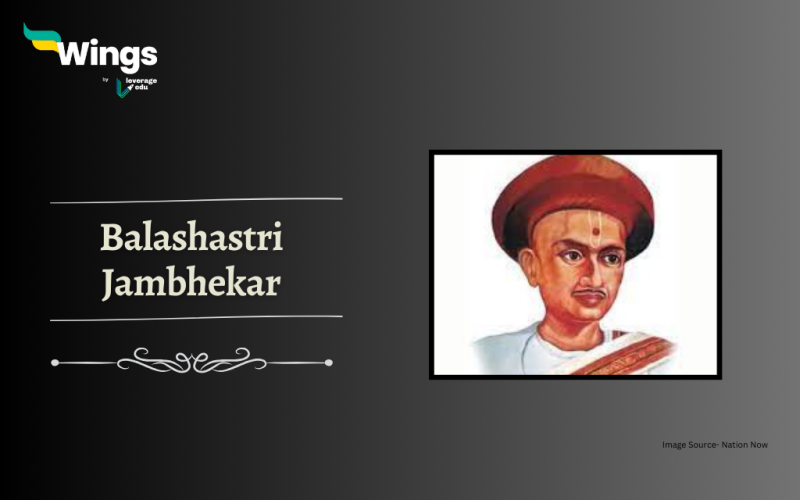Bal Ganghadhar Shastri Jambhekar also known as Balshastri Jambhekar is popularly known as the father of Marathi journalism and was a great figure in the history of Indian journalism. He played a crucial role in the development and progress of journalism, not just in Maharashtra but throughout India. This article explores the life and contributions of Balshastri Jambhekar along with details on his early life, social involvement, and significant contributions to the field of journalism.
Table of Contents
Early Life of Balshastri Jambhekar
Balshastri Jambhekar was born on January 6, 1812, in the village of Pombhurle, Konkan Region in Maharashtra.
- From an early age, he displayed a keen interest in learning and showed remarkable linguistic abilities.
- At the age of 12, Jambhekar composed his first Marathi poem and showcased his talent and creativity.
- He received his education in Pune and immersed himself in the world of literature and philosophy.
- He was a master of many languages including foreign languages like Greek, Latin, French, English, etc
Also Read – Brahmo Samaj: Founder, History, Significance
Balshastri Jambhekar actively participated in the social and cultural movements of his time.
- He strongly advocated for women’s education and worked towards the upliftment of the lower castes.
- Jambhekar believed in the development of a scientific set of mind and championed the cause of providing education to all sections of society.
- He was just 20 years also when he started a Marathi newspaper and dealt with the issue of Widow remarriage through his thoughtful articles.
Also Read – Henry Vivian Derozio: Life, Education, Role & Legacy
Contributions of Balshastri Jambhekar to Indian Journalism
Balshastri Jambhekar can be credited with starting the first Marathi newspaper in India, “Darpan,” in 1832.
- The first edition of Darpan was published on 6th January 1832.
- Through his newspaper, Jambhekar aimed to create awareness among the masses and educate them about the social, political, and cultural issues of the time.
- “Darpan” served as a platform for expressing dissent against unjust practices and raising voices against social inequalities.
- The newspaper was priced at 1 rupee as it was a new concept in the region.
- Publishing of the newspaper continued for eight and half years and the last publication was in July of 1840.
- He also founded “The Bombay Native General Library” and “ Native Improvement Society” for students.
- In 1840, he started the first Marathi Monthly magazine known as Digdarshan.
- He edited the magazine for nearly five years and wrote on various topics like physics, chemistry, history, etc.
- He was also responsible for printing Dnyaneshwari ( a commentary on the Holy Bhagwat Gita) in the year 1845.
- He was also the first Hindi professor at Elphinstone College of Mumbai.
Impact and Legacy of Balshastri Jambhekar
Balshastri Jambhekar’s pioneering efforts in journalism laid the foundation for modern-day journalism in India.
- He was the first Indian to have published a research paper in the quarterly journal of the Asiatic Society.
- Leaders like Atmaram Pandurang, Bal Shastri, and Dadabhai Naoroji are some of his disciples from Elphinstone College.
- He also wrote books like Neetikatha, Encyclopedic History of England, History of India Mathematics based on Zero, English Grammar, etc.
He died in Baneshwar on 18th May at the young age of 34 years. Because of his exemplary work on print media, his birthday is known as Journalism Day in Maharashtra i.e. on the 6th of January every year. Balshastri Jambhekar’s contributions to Indian journalism are invaluable. He not only laid the foundation for Marathi journalism but also played a crucial role in revolutionizing the entire field of journalism in India. Through his newspapers, he ignited social and political change, advocating for equality, education, and women’s empowerment.
Relevant Blogs
| Widow Remarriage Act | Ishwar Chandra Vidyasagar |
| Indira Gandhi | Swaraj Party |
| Peasant Movements | Kiran Bedi |
| Prarthana Samaj | Arya Samaj |
| Bengal Partition | Birsa Munda |
We hope you liked our blog. If you want to read more articles like this you can visit our general knowledge page on Indian History!
 One app for all your study abroad needs
One app for all your study abroad needs













